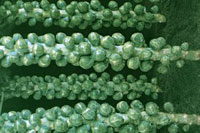Brussels Sprouts
 Brussels Sprouts are an invaluable winter vegetable and are improved by winter frosts. They do however need a lot of room and a long time to grow.
Brussels Sprouts are an invaluable winter vegetable and are improved by winter frosts. They do however need a lot of room and a long time to grow.
They need a firm, well drained, medium to heavy soil that is not too rich. A site that has been used for a previous crop that has been manured is ideal. They also need a pH of 6.5 - 7.0, so it is wise to check this and apply lime if necessary. Apply a general fertiliser at the rate of 2 - 3oz per square yard before planting.
Sow the seed thinly in a shallow seed drill, in mid or late spring, and thin to 6".
Transplant to the final growing positions when they are 3" high. If you are going to use the Sprouts fresh, space the plants 36" apart each way but if you intend to use the crop for freezing and require smaller sprouts, you can space them 24" apart each way.
If Clubroot tends to be a problem, the seeds can also be sown in pots or trays in the greenhouse or coldframe and when the seedlings have formed two leaves transplant to 3" cell trays. Grow on until they are 3" - 4" inches tall and then transplant them to the final positions. This gives the plant chance to get a good root system before being exposed to the virus. Use one of the commercial Clubroot dips when planting out.
It is also a good idea to treat the ground when planting with a soil pest killer such as Chlorophos as a prevention against Cabbage root fly.
As they are a fairly tall plant, they may need staking in more exposed areas.
Harvest the Sprouts as required from mid autumn right through to early spring, by picking from the bottom of the plant, upwards. Remove any yellowing or dead leaves as you pick.
Brussels Sprouts are subject to all the usual Brassica pests and diseases such as Club root, Cabbage root fly, Cabbage white caterpillars, Mildew and whitefly. (See relevant Pests or Diseases sections)
© copyright 1999, P. A. Owen

